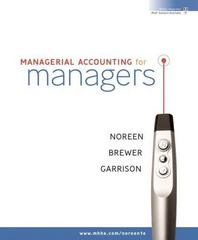Question
Question 1: Best Brew Manufacturing Company has two Service Departments-Custodial Services and Maintenance and three Production Departments-Brewing, Bottling, and Packaging. Best Brew allocates the cost
Question 1:
Best Brew Manufacturing Company has two Service Departments-Custodial Services and Maintenance and three Production Departments-Brewing, Bottling, and Packaging. Best Brew allocates the cost of Custodial Services on the basis of square metres and Maintenance on the basis of labour hours.
Budgeted operating data for the year just completed follow:
Service Departments Operating Departments
Custodial Maintenance Brewing Bottling Packaging
Budgeted costs before allocation $18,000 $8,000 $80,000 $50,000 $90,000
Square metres 1,000 10,000 5,000 22,000 13,000
Labour-hours - - 4,000 8,000 8,000
Required:
1) a schedule, which allocates Service Department costs to the Production Departments by the direct method.
2) a schedule, which allocates Service Department costs to the Production Departments by the step-down method, allocating Custodial Services first.
Question 2:
Tabulation Corporation manufactures and sells two types of electronic calculators: EL-520 W and EL-620
T. The following data was gathered from last month's activities:
EL-520 W EL-620 T
Sales in units 5,000 3,000
Selling price per unit $50 $100
Variable production costs per unit $10 $26
Traceable fixed production costs $100,000 $150,000
Variable selling expenses per unit $5 $6
Traceable fixed selling expenses $5,000 $7,500
Allocated division administrative expenses $50,000 $60,000
Required:
1) a segmented income statement in the contribution format for last month, showing both
"Amount" and "Percent" columns for the company as a whole and for each model.
2) Why might it be very difficult to calculate separate break-even sales for each model?
3) Refer to the original data and, if necessary, the results of the segmented income statement
prepared in part (1) above. Calculate the total break-even sales (in both units AND dollars) for
last month, assuming that none of the fixed production costs and fixed selling expenses is
traceable. Allocate the total break-even sales between the two models.
4) Again, refer to the original data and, if necessary, the results of the segmented income
statement prepared in part (1) above. Calculate the total break-even sales (in both units AND
dollars) for last month, assuming that the "allocated" amounts of the company's administrative
expenses are actually traceable. Allocate the total break-even sales between the two models.
5) How reasonable are the total break-even sales numbers calculated in parts (3) and (4) given the
actual results for last month?
Question 3:
The following data is provided on behalf of Mittens Incorporated for last year appear below:
Mittens Incorporated
Statements of Financial Position
For the Year Ended June 2020
Beginning Balance Ending Balance
Assets:
Cash $135,000 $266,000
Accounts receivable 225,000 475,000
Inventory 314,000 394,000
Plant and equipment (net) 940,000 860,000
Investment in Scarf Company 104,000 101,000
Land (undeveloped) 198,000 65,000
Total assets $1,916,000 $2,161,000
Liabilities and owners' equity:
Accounts payable $88,000 $119,000
Long-term debt 585,000 665,000
Owners' equity 1,243,000 1,377,000
Total liabilities and owners' equity $1,916,000 $2,161,000
Mittens Incorporated
Income Statement As at June 2020
Sales $4,644,000
Less operating expenses 4,291,000
Net operating income 353,000
Less interest and taxes:
Interest expense $90,000
Tax expense 129,000 219,000
Operating Income $134,000
The "Investment in Scarf Company" on the statement of financial position represents an investment in
the stock of another company.
Required:
1) Compute the company's margin, turnover, and return on investment for last year.
2) The Board of Directors of Mittens Company have set a minimum required return of 15%. What
was the company's residual income last year?
Question 4:
Heisenberg Corporation has a Moldings Division that does molding work of various types. The
company's Machine Products Division has asked the Moldings Division to provide it with 20,000 special
moldings each year on a continuing basis. The special moldings would require $10 per unit in variable
production costs. The Machine Products Division has a bid from an outside supplier of $29 per unit for
the moldings.
In order to have time and space to produce the new moldings, the Moldings Division would have to cut
back production of another molding: the Blue4, which it presently is producing. The Blue4 sells for $30
per unit, and requires $12 per unit in variable production costs. Boxing and shipping costs of the Blue4
are $4 per unit. Boxing and shipping costs for the new special molding would be only $1 per unit. The
company is now producing and selling 100,000 units of the Blue4 each year. Production and sales of this
molding would drop by 20% if the new molding is produced.
Required:
1) What is the range of transfer prices within which both the divisions' profits would increase as a
result of agreeing to the transfer of 20,000 moldings per year from the Moldings Division to the
Machine Products Division?
2) Is it in the best interests of Heisenberg Corporation for this transfer to take place? Explain.
Step by Step Solution
There are 3 Steps involved in it
Step: 1

Get Instant Access to Expert-Tailored Solutions
See step-by-step solutions with expert insights and AI powered tools for academic success
Step: 2

Step: 3

Ace Your Homework with AI
Get the answers you need in no time with our AI-driven, step-by-step assistance
Get Started


